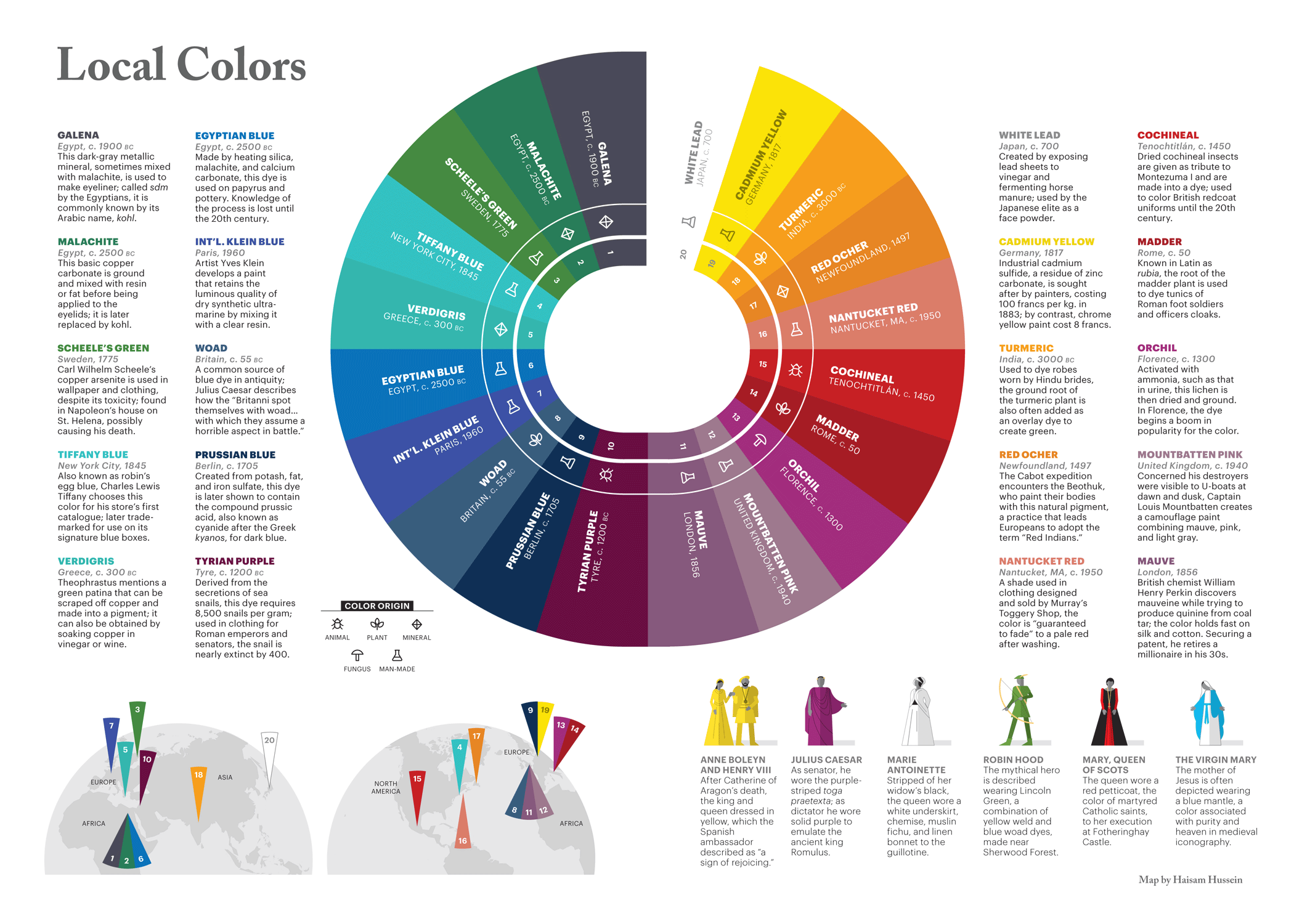Mapping Color in History unravels the vibrant narrative of South Asian pigments, inviting art enthusiasts and historians alike to delve into the rich tapestry of color that has defined ancient Indian art. Through meticulous pigment analysis, the project not only enhances our understanding of traditional art conservation but also sheds light on the historical significance of these colors in cultural contexts. This innovative integration of digital humanities is transforming the way we appreciate and study the intricate artworks of South Asia. By challenging the Eurocentric perspectives often found in existing databases, Mapping Color in History aims to uncover indigenous knowledge and practices surrounding colorants that have long been overlooked. Join us on this journey to rediscover the historical pigments and their origins, while fostering a deeper appreciation for the artistry that has shaped our visual heritage.
The exploration of chromatic history, particularly through the lens of South Asian art, sheds light on the indigenous pigments and their applications over centuries. This undertaking emphasizes the importance of color analysis within art conservation, as historical records and modern scientific methods converge in a remarkable study of ancient visual traditions. By employing a digital humanities approach, researchers seek to document and catalog the rich spectrum of colors used in Indian art, providing new insights into the material culture. In this context, Mapping Color in History serves as a critical resource for understanding how artists of the past utilized available pigments, thereby enriching our knowledge of their creative processes. Ultimately, this endeavor fosters a richer dialogue between art history and contemporary practices, bringing to light the stories that colors have told throughout time.
Understanding South Asian Pigments: A Historical Perspective
The fascinating world of South Asian pigments unveils a rich tapestry of artistic practices that date back centuries. Traditionally, Indian art has been characterized by its vibrant use of color, with pigments sourced from minerals, plants, and even insects. These indigenous colorants have played a significant role in the visual narrative of ancient Indian art, revealing the cultural significance and practices of the time. By analyzing various artworks, researchers strive to document this historical pigment usage and its evolution over time, which is crucial for a comprehensive understanding of South Asian art history.
Recent advances in pigment analysis have allowed scholars to identify and classify these historical materials with greater accuracy. This method does not solely rely on the visual aspects of the art but also incorporates scientific techniques that can unveil the detailed composition of pigments used. Such studies contribute to a more nuanced understanding of artistic methodologies and the interchange of cultural knowledge across generations, ultimately enriching our appreciation for South Asian cultural heritage and artistry.
Mapping Color in History: Innovations in Art Conservation
The Mapping Color in History project represents a groundbreaking effort in art conservation, bringing together digital humanities and rigorous scientific analysis to safeguard and understand South Asian art. This project aims to create a comprehensive pigment database that highlights the diverse materials employed by artists over the centuries. By mapping these colors back to their sources, researchers can reconstruct historical pigment usage and gain insights into the techniques that shaped the visual narratives of the past.
In addition to enhancing conservation efforts, this innovative approach allows for a multifaceted examination of artworks, merging the scientific realm with art historical research. The collaborative nature of the project is vital; it requires contributions from conservation scientists, art historians, and digital specialists, exemplifying how interdisciplinary dialogue can foster greater innovation in preserving and contextualizing historical works. Such initiatives also empower future generations of scholars and practitioners to explore the rich legacy of South Asian art without the constraints of a Eurocentric perspective.
The Role of Digital Humanities in Art Analysis
Digital humanities play a pivotal role in the modern analysis of art, particularly in projects like Mapping Color in History. By leveraging technology, researchers can create interactive databases that not only catalog pigment data but also enhance accessibility for scholars across various fields. This interactivity allows users to explore relationships between different artworks, pigments, and historical contexts, thereby deepening their understanding of the cultural significance and evolution of South Asian art.
Moreover, the integration of digital tools enables the visualization of complex data trends that may not be immediately obvious through traditional methods. Scholars can track the movement of particular pigments over time and space, offering valuable insights into trade routes, cultural exchange, and artistic innovation. The fusion of art and technology in this manner not only preserves historical knowledge but also opens new avenues for research, enabling a more nuanced understanding of the artistic legacy of South Asia.
Analyzing Ancient Indian Art: Non-Destructive Techniques
The careful analysis of ancient Indian art poses unique challenges, particularly when it comes to preserving the integrity of the artworks. Non-destructive techniques have become essential in art conservation, allowing scientists to study and identify pigments without damaging fragile pieces. Methods such as infrared and ultraviolet imaging, x-ray fluorescence, and Raman spectroscopy provide invaluable insights into the composition and condition of pigments, revealing layers of historical craftsmanship.
Through these techniques, conservators can elucidate the choices artists made, such as the combination of pigments to achieve specific hues or effects. For instance, identifying the presence of traditional pigments like Indian Yellow or orpiment in historic artworks can illuminate the methods and intentions behind their creation. This careful examination enhances the understanding of not just the artwork itself, but also the broader cultural contexts in which these artistic practices occurred.
The Importance of Collaboration in Art Research
Collaboration is vital in advancing the field of art research, particularly within projects like Mapping Color in History. By uniting experts from various disciplines—ranging from conservation science to digital technologies—researchers can tackle complex questions regarding pigment use and historical practices in a more holistic manner. This interdisciplinary approach ensures that findings are not isolated; instead, they contribute to a deeper understanding and appreciation of South Asian art as a whole.
Collaborative projects also facilitate knowledge exchange, allowing subjective art historical perspectives to inform scientific analyses and vice versa. This synergy fosters greater innovation, enabling the development of tools and methodologies that can be applied across similar fields. As art conservation continues to evolve, the emphasis on partnership across disciplines will be essential in preserving cultural heritage for future generations.
Preserving Cultural Heritage Through Pigment Analysis
Preservation of cultural heritage is paramount, especially when it comes to the historical art of South Asia. Artistic materials used in ancient pieces often carry significant cultural narratives that must be understood and respected. Pigment analysis serves as a crucial tool in this preservation process, helping conservators identify how colorants were historically made and used. By documenting these materials, we create a reference point for both future conservation efforts and the understanding of artistic practices.
Through rigorous scientific methods and detailed art research, scholars can gain insights into both the materials and their cultural implications. For example, discovering the origins of particular pigments could reveal trade relationships or cultural exchange between regions, enriching our understanding of historical interactions. This meticulous endeavor not only safeguards the physical integrity of the artworks but also honors the cultural legacies they represent.
Cultural Significance of Color in Ancient Indian Society
In ancient Indian society, color was not just a visual element but also a symbol of deeper cultural and spiritual significance. Colors in artworks were often used to convey meanings and emotions, influencing everything from religious practices to social dynamics. For instance, the vibrant use of color in temple murals and manuscripts was intended to evoke a sense of the divine, aligning artistic expression with cultural beliefs. This highlights how integral color was to the communication of societal values and traditions.
Studying the significance of color within the context of ancient Indian art provides valuable insights into the beliefs and practices of the time. By analyzing the pigments used in various artworks, researchers can decode the layers of meaning embedded within the visual language of the past. Exploring this cultural dimension fosters a more profound appreciation for the artistry of South Asian traditions, emphasizing the importance of color as a reflection of identity and heritage.
Impact of Modern Techniques on Traditional Art Forms
Modern techniques of pigment analysis bring a fresh perspective to traditional art forms, allowing for a deeper understanding of historical methods. By applying scientific technology to the study of South Asian pigments, researchers can uncover new layers of information about how artworks were created and the materials employed. This intersection of modernity and tradition not only aids in the preservation of these art forms but also inspires contemporary artists who seek to revitalize traditional practices with modern insights.
Furthermore, employing modern analysis tools can respect and maintain the authenticity of traditional artworks while enabling innovations. As artists and conservators explore the findings of pigment studies, they may find ways to adapt ancient techniques for contemporary contexts, ensuring that these rich traditions continue to thrive. Ultimately, the dialogue between old and new fosters a dynamic and evolving artistic landscape that celebrates and honors the roots of South Asian artistry.
Future Directions in Art Conservation and Research
Looking ahead, the field of art conservation stands at a crossroads where new methodologies and interdisciplinary collaboration promise to redefine traditional practices. The Mapping Color in History project exemplifies this potential by integrating digital tools and scientific analysis with historical art research, paving the way for innovative approaches to preserving cultural heritage. Future research will likely expand on these foundational efforts, exploring additional pigments, analytics, and historical contexts that deepen our understanding of art’s evolution.
Anticipated advancements in technology, such as artificial intelligence and machine learning, could further enhance the analysis and cataloging of art materials, making vast data sets more manageable and insightful. By employing these cutting-edge techniques alongside existing methodologies, researchers can uncover trends and connections previously obscured, enriching our cultural narratives and solidifying the importance of South Asian art within the global art historical canon.
Frequently Asked Questions
What is the Mapping Color in History Project and its significance in understanding South Asian pigments?
The Mapping Color in History Project is an initiative aimed at creating an object-based pigment database for historical research on South Asian art. It seeks to uncover the diverse pigments used in ancient Indian art by analyzing artworks through modern scientific methods. The project holds significance as it challenges the previously Western-centric narratives of pigment use, providing a platform for understanding indigenous colorants and enriching the field of art conservation and digital humanities.
How does the Mapping Color in History Project contribute to art conservation?
The Mapping Color in History Project enhances art conservation by utilizing non-destructive methods to analyze pigments in artworks. Through techniques like UV light imaging and x-ray fluorescence, conservators gain insights into the materials used by artists, allowing for more informed preservation strategies. This approach helps maintain the integrity of ancient Indian art and informs future conservation practices.
In what ways does the Mapping Color in History integrate digital humanities in art research?
The Mapping Color in History integrates digital humanities by creating an open-access database that combines artistic and scientific data. This collaboration facilitates research and allows users to interactively explore the pigments used in different artworks. By linking digitized art analysis with historical context, the project fosters interdisciplinary dialogue among art historians, conservators, and digital scholars.
What methods are utilized in pigment analysis within the Mapping Color in History Project?
Pigment analysis in the Mapping Color in History Project employs various non-destructive methods such as imaging techniques that identify pigments under different light conditions, x-ray fluorescence for elemental analysis, and Raman spectroscopy to determine pigment composition at the molecular level. These innovative techniques allow scientists to uncover the complexities of ancient Indian art without compromising the integrity of the artworks.
Why is understanding South Asian pigments important for art historians and researchers?
Understanding South Asian pigments is crucial for art historians and researchers as it reveals insights into the cultural and historical contexts of ancient Indian art. By mapping the origins and compositions of pigments, scholars can gain a deeper appreciation of artistic practices, trade routes, and technological advancements in pigment usage. This knowledge enhances art conservation efforts and informs future research in the field of cultural heritage.
Can students and educators benefit from the Mapping Color in History database?
Yes, students and educators can greatly benefit from the Mapping Color in History database. It serves as a valuable educational resource that allows for hands-on exploration of pigment usage in historical artworks. By accessing detailed analyses and contextual information, learners can engage with topics related to South Asian art, conservation practices, and the role of digital humanities in research.
How does the Mapping Color in History Project redefine the narrative of pigment use in ancient Indian art?
The Mapping Color in History Project redefines the narrative of pigment use in ancient Indian art by challenging the assumption that pigments were primarily imported from Europe. It presents evidence that many colorants used in South Asia may have indigenous origins, thus enriching the understanding of local artistic traditions. This paradigm shift encourages further research into the historical practices surrounding pigment production and usage in the region.
What challenges does the Mapping Color in History Project face in mapping the origins of painted artworks?
One of the main challenges the Mapping Color in History Project faces is the often vague provenance of historical paintings, as artworks from South Asia frequently lack precise information regarding their date, location, and artist. This ambiguity complicates the task of accurately mapping the origins of pigments and necessitates extensive research to improve attributions and enhance the database’s overall quality.
| Key Points | Details |
|---|---|
| Project Initiation | The Mapping Color in History Project was initiated by Jinah Kim in 2018. |
| Purpose | To create an object-based pigment database specifically for historical South Asian art. |
| Findings | Some pigments believed to be European imports may have been used in South Asia long before. |
| Data Accessibility | The database is open-access, allowing users to search by various criteria including title, pigments, and location. |
| Collaboration | The project collaborates with experts in various fields like digital humanities and conservation science. |
| Research Methods | Non-destructive methods are primarily used for analyzing pigments in ancient artworks. |
| Educational Use | The database serves not only researchers but is also meant for art historians, educators, and students. |
Summary
Mapping Color in History sheds light on the intricate relationships between pigments, artistry, and cultural heritage in South Asia. This innovative project showcases how historical art can be revitalized through scientific analysis, revealing the extensive diversity of colorants that have been used over centuries. By expanding our understanding beyond the Western European canon, Mapping Color in History opens new avenues for appreciating the rich tapestry of South Asian art and inspires ongoing dialogue across disciplines.




